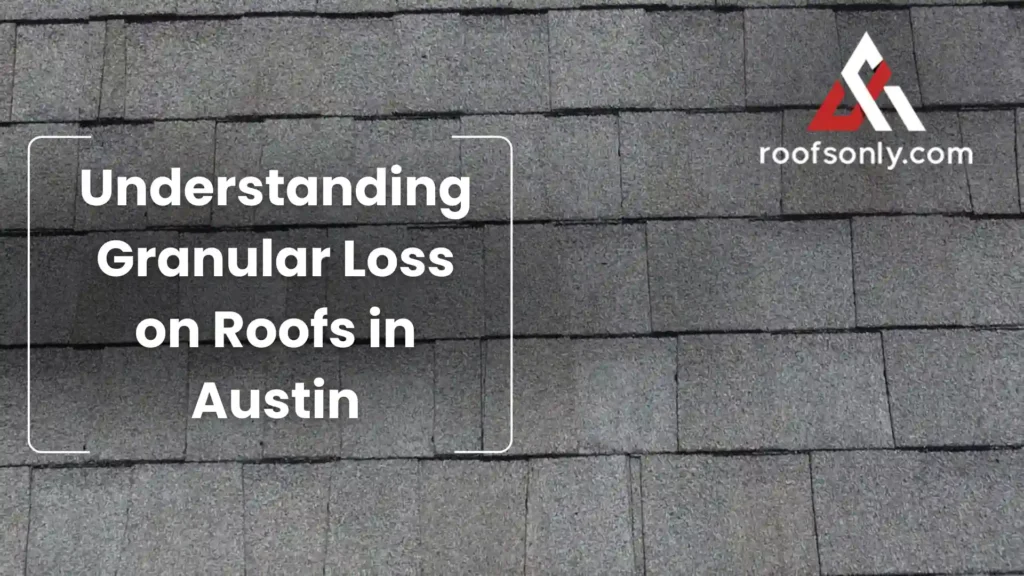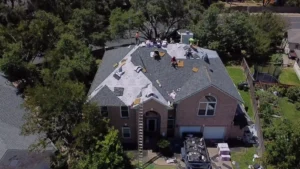Posted on Thursday, March 28th, 2024 at 6:35 pm

As a homeowner in Austin, you want your roof to protect your home from the elements for as long as possible. However, your roof may experience various issues over time, including shingle granule loss. This common problem affects many roofing systems, particularly those with asphalt shingles. It’s important to understand granular loss, its causes, and how to address it to keep your roof in top shape.
What is Granular Loss?
Granular loss, or granule loss, is the gradual shedding of the mineral granules embedded in asphalt shingle roofs. These granules, typically made of crushed mineral or ceramic, serve multiple purposes. They protect the shingles from UV rays, enhance their color and look, and safeguard the asphalt layer against water damage and other environmental impacts.
The shingle granules on your asphalt shingles are crucial in extending your roof’s lifespan. When these granules wear away and fall off, they leave the underlying asphalt exposed to the weather, which speeds up the aging process and raises the risk of leaks and other roof problems.
Is it Normal for a New Roof to Lose Granules?
If you’ve recently installed a new asphalt shingle roof, you may notice some granular loss in the first few weeks or months. This is normal, as loose granules that didn’t adhere properly during manufacturing will wash away. However, if significant granule loss persists after this initial period, it might signal a more serious problem that needs a roofing expert’s attention.
It’s important to monitor both new and older roof systems closely, as older roofs are particularly susceptible to issues like granule loss. While a small amount of shedding is normal, excessive granule loss on an older roof can be a red flag that immediate attention is needed.
What Causes Granule Loss on Shingles?
Several factors can contribute to granular loss on asphalt shingle roofs:
- Age: As your roof’s age increases, the asphalt layer that secures the granules begins to break down, resulting in increased granule loss.
- Weather: Austin’s harsh weather conditions, including strong winds, heavy rain, and hail, can accelerate granular loss by physically dislodging the granules from the shingles.
- Poor Installation: Improper installation techniques or using low-quality materials can result in premature granular loss and other roofing issues.
- Manufacturing Defects: In some cases, granular loss can stem from defects during the shingle manufacturing process, such as poor granule adhesion or inconsistent asphalt application.
- Stress from Foot Traffic: Although we recommend avoiding unnecessary trips onto your roof, sometimes repairs or maintenance make it necessary. Walking on a steep slope roof can significantly increase the likelihood of knocking loose the granules.
How Much Granule Loss is Too Much?
While a little granular loss is normal, too much can expose the asphalt beneath to UV rays and water damage, which can weaken your roof’s structure.If you notice any of the following signs, it may indicate significant granular loss that requires professional attention:
- Visible Bald Spots: If you can see patches of exposed asphalt on your shingles, it’s a clear sign of advanced granular loss. These bald spots indicate the protective granule layer has worn away, leaving the asphalt vulnerable to the elements.
- Dark Stains on Gutters or Downspouts: As granules wash away, they often gather in gutters and downspouts, creating dark stains or gritty deposits. A large presence of granules in your gutters or downspouts usually indicates excessive granule loss from your roof.
- Inconsistent Shingle Color: Uneven granule distribution can lead to damage or varied coloration across your roof’s surface. If some areas of your roof appear lighter or darker than others, it may be due to granule loss.
- Premature Aging: If your roof is relatively new but shows signs of rapid aging, such as cracking, curling, or damaged shingles, this could be due to excessive granule loss. Compromised protective layers make shingles more vulnerable to damage from UV rays and other environmental elements.
Addressing Granular Loss
If you suspect your roof is experiencing significant granular loss, acting promptly to minimize further damage is crucial. Here are some steps you can take:
- Schedule a Professional Roof Inspection: A qualified roofing professional can assess the extent of the granular loss and recommend the best course of action, whether it’s targeted repairs or a full roof replacement.
- Consider Protective Coatings: In some cases, applying a fire resistant, specialized coating to your asphalt shingles can help slow down granular loss and extend your roof’s lifespan.
- Invest in Regular Maintenance: Scheduling annual roof inspections and performing routine maintenance tasks, like cleaning gutters and trimming overhanging branches, can help prevent granular loss and other common roof problems.
- Address Underlying Issues: If your roof is experiencing granular loss due to other problems, such as poor ventilation or structural damage, it’s essential to address those issues as well. Failing to do so may result in continued granule shedding and more severe roofing problems down the line.
Signs it’s Time to Replace Your Roof
 While addressing granular loss can help prolong your roof’s life, there may come a point when a full roof replacement is necessary. Watch for these signs that indicate it’s time for a new roof:
While addressing granular loss can help prolong your roof’s life, there may come a point when a full roof replacement is necessary. Watch for these signs that indicate it’s time for a new roof:
- Age: If your asphalt shingle roof is more than 20-25 years old, it’s likely nearing the end of its lifespan.
- Widespread Damage: If granular loss accompanies other issues such as cracked, curled, or missing shingles, extensive moss or algae growth, or visible daylight through the roof boards, replacing the roof may be the most cost-effective solution.
- Frequent Leaks: If you constantly deal with roof leaks and repairs, investing in a new roof may be more economical in the long run.
- High Energy Bills: An aging, damaged roof can allow heat to escape, leading to increased energy costs. A new, energy-efficient roof can help reduce your utility bills.
- Sagging or Drooping: If your roof is sagging or drooping in certain areas, you should address this serious concern immediately.
Consulting an experienced Austin roof replacement contractor can help you select the optimal materials and options for your new roof, ensuring it provides long-lasting protection and efficiency.
Trust the Professionals at RoofsOnly.com
If granular loss or other roofing problems are a concern for your Austin home, consider consulting the experienced professionals at RoofsOnly.com. Our skilled team will work with you to assess your roof’s condition, recommend the best solution, and provide top-quality roof installation and repair services.
As a top Austin roofing contractor, we’re well-versed in the local climate’s unique challenges and committed to helping homeowners safeguard their investments. Whether it’s a basic repair or a complete roof replacement, we use only premium materials and meet industry standards to deliver durable, enduring results. Contact us today using our online form or call us at (737) 275-7599 for a free roof inspection!
Related Reading:

